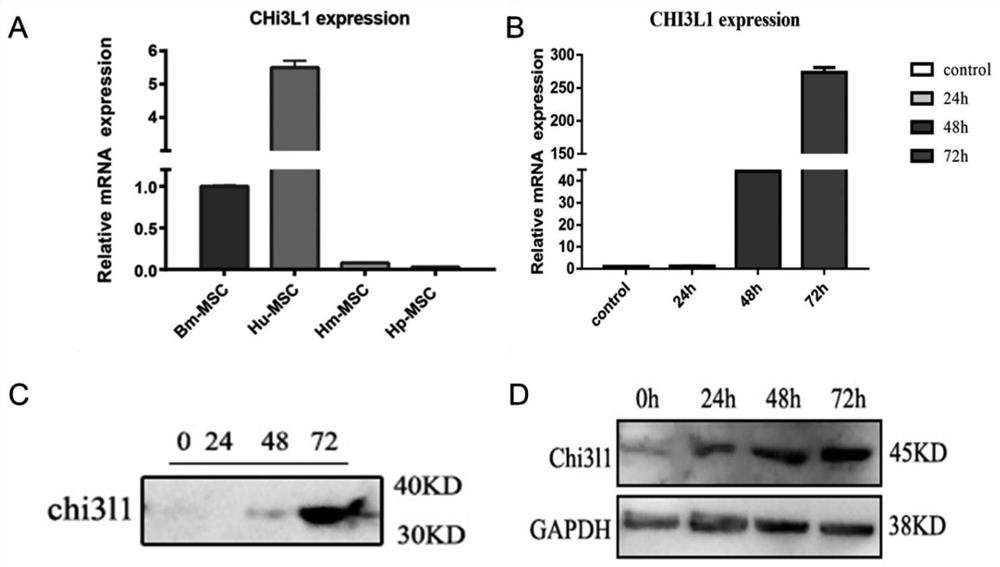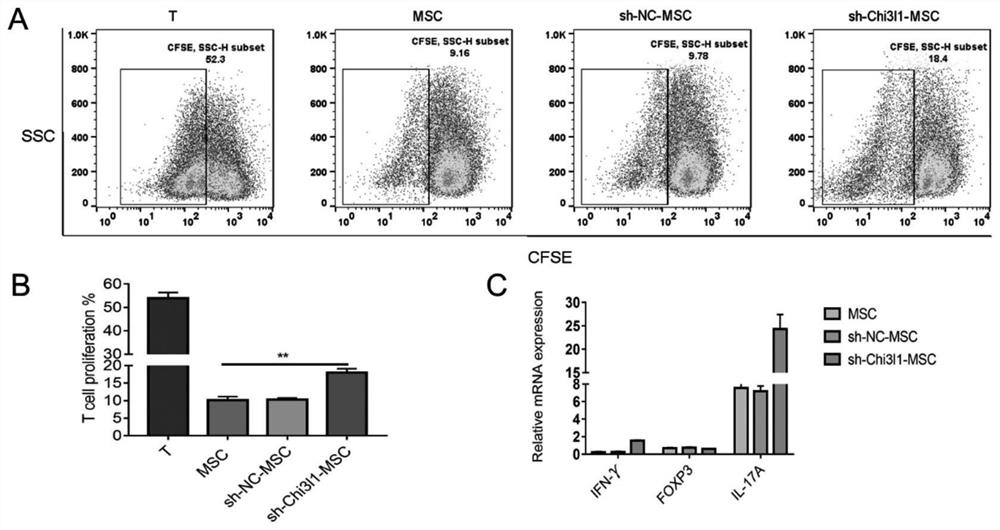Application of Chi3l1 in regulation and control of immune regulation effect of hUC-MSCs for inhibiting Th17 differentiation meditation
A technology of immune regulation and action, applied in the biological field, can solve the problems such as unclear main mechanism of action of aGvHD
- Summary
- Abstract
- Description
- Claims
- Application Information
AI Technical Summary
Problems solved by technology
Method used
Image
Examples
Embodiment 1
[0027] Example 1 Inflammatory factors IFN-γ combined with TNF-α stimulate hUC-MSCs to highly express Chi3l1
[0028] The inflammatory factor IFN-γ combined with TNF-α (20ng / ml) stimulated hUC-MSCs for 24h, 48h, and 72h, respectively, and then the total RNA, total protein and supernatant protein of the cells were extracted, and the real-time fluorescent quantitative PCR technology (q-PCR ) and Western Blot to detect the expression of Chi3l1.
[0029]
[0030] like figure 1 As shown in A, in mesenchymal stem cells derived from human bone marrow (Bm-MSC), amniotic membrane (Hm-MSC), placenta (Hp-MSC), and umbilical cord (Hu-MSC), Chi3l1 is highly expressed in hUC-MSCs; as figure 1 As shown in B, the expression of Chi3l1 is high after stimulation of hUC-MSCs by inflammatory factors IFN-γ and TNF-α; figure 1 As shown in C, Western Blot detected the high expression of Chi3l1 in the supernatant of hUC-MSCs stimulated by IFN-γ and TNF-α; figure 1 As shown in D, Western Blot dete...
Embodiment 2
[0031] Example 2 lentiviral vector transfection of hUC-MSCs
[0032] The sh-Chi3l1 vector was constructed by using lentivirus to infect hUC-MSCs, and the stably expressed sh-Chi3l1-hUC-MSCs were obtained, and the vector was GV493. A total of 3 lentiviral vectors were constructed, and the 75488 with the highest knockdown efficiency was selected for subsequent experiments.
[0033] Chi3l1-RNAi (75488) ACCCACATCATCTACAGCTTT Chi3l1-RNAi (75489) CAGCAGCTATGACATTGCCAA Chi3l1-RNAi (75490) AGGTGCAGTACCTGAAGGACA
[0034] The recovered hUC-MSCs P2 generation cells were inoculated into six-well plates, and the number of inoculated cells was 1×10 5 . Replace the medium with 10% FBS α-MEM complete medium containing 4 μl / ml HiTransGA, add virus suspension (titer is MOI=10, transfection virus amount is 1×10 7 24h after transfection, replace the medium with 2ml α-MEM complete medium containing 10% FBS, and carry out amplification culture, add puromycin (2μmol / ...
Embodiment 3
[0035] Example 3 co-culture of sh-Chi3l1-hUC-MSCs and T cells
[0036]hUC-MSCs, sh-Chi3l1-hUC-MSCs, sh-NC-hUC-MSCs were co-cultured with mouse T lymphocytes, and T cells were activated by anti-CD3. CFSE dyes were used to label the two groups of lymphocytes, and flow cytometry Cytometry detection of T cell proliferation:
[0037] a) separating T lymphocytes with mouse spleen lymphocyte separation liquid;
[0038] b) The anti-CD3 antibody was diluted with PBS to 1 μg / ml, added to a 96-well plate (50 μl / well), transferred to 37°C and incubated for 2 hours;
[0039] c) Discard the coating solution of the 96-well plate, wash twice with PBS, and add CFSE-stained T lymphocytes (2.5×10 4 / well), while adding hUC-MSCs, sh-Chi3l1-hUC-MSCs, sh-NC-hUC-MSCs respectively, and co-cultured for 72h;
[0040] d) Collecting the co-cultured T lymphocytes, and detecting the proliferation ratio and cell subsets of T lymphocytes by flow cytometry.
[0041] e) Total RNA of T cells after co-cult...
PUM
 Login to View More
Login to View More Abstract
Description
Claims
Application Information
 Login to View More
Login to View More - R&D
- Intellectual Property
- Life Sciences
- Materials
- Tech Scout
- Unparalleled Data Quality
- Higher Quality Content
- 60% Fewer Hallucinations
Browse by: Latest US Patents, China's latest patents, Technical Efficacy Thesaurus, Application Domain, Technology Topic, Popular Technical Reports.
© 2025 PatSnap. All rights reserved.Legal|Privacy policy|Modern Slavery Act Transparency Statement|Sitemap|About US| Contact US: help@patsnap.com



